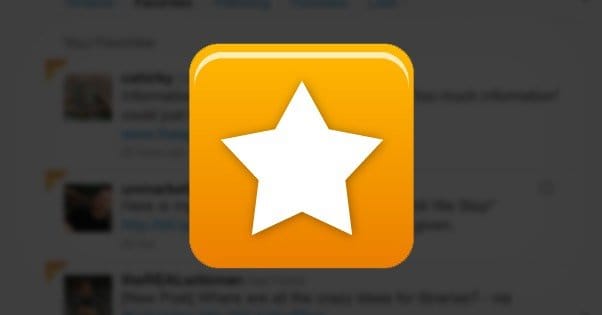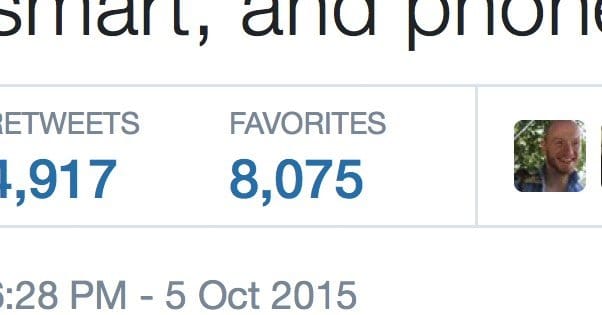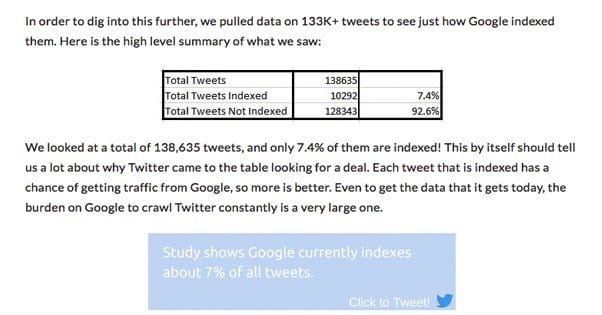 Written by ContentPowered.com
Written by ContentPowered.com
Twitter Favorites have a bit of a bad rap, and it stems from years ago, when they truly were essentially valueless for most uses. These days, though, they’re significantly more valuable, or at least less restricted, than they used to be. What am I talking about?
When a user makes a tweet on Twitter, it appears in the feeds of everyone who follows that user. Those users have a small handful of possible actions they can take. They can reply to the user, which is just a tweet that starts with the @username of the user. They can retweet it, which posts it in their feed for their followers to see. They can favorite it, which adds it to a list of their favorite tweets and has a few other effects. They can also expand the … icon to do other things, like share the tweet in a direct message, copy the link to the tweet, embed it, or perform negative actions like mute the user, block them, or report the tweet.
Among all of these actions, some are more valuable than others. For a business, the two most valuable are the retweet and the reply. Replies are great for relationship building opportunities. Retweets are perfect for expanded reach and engagement.
Favorites seem like the odd one out. On the surface, they just look like Facebook Likes. In fact, many users use the function in the same way they use Likes. As we all know, as well, Facebook likes tend to be fairly valueless. No search engine cares about the number of likes a post has. They don’t significantly increase reach or exposure. They generally don’t do a whole heck of a lot.
So why are favorites compared to likes? Are they really that bad, or do they have hidden value?
How Favorites Used to Work
Back in the day, Twitter favorites were a very limited type of engagement, hardly engagement at all. When a user favorited a tweet, that tweet was added to a list of their favorite tweets. That was it! The user could look back and see all of their favorite tweets in a list, but that was all they could really do with them. The people whose tweets were favorited didn’t get anything out of the transaction other than a feel-good notification in their inbox. Third parties couldn’t see those favorite lists either. There was no real reason to push for favorites at all. You can see an old blog post railing against them here.
Things have changed in the last two years, though. How do favorites work now?
The Modern Favorite
I can log on to my Twitter account right now and see a feed of tweets from people. Most of these tweets have anywhere from 1-10 favorites. Tweets from more prominent entities have more. For example, one from Clickhole has 30, one from Bernie Sanders has almost 90, one from a prominent Twitter comedian has 350, and a string from Neil DeGrasse Tyson all have between 1900 and 3500.
So there’s change number one: as a third party – that is, as neither the person whose tweet was favorited, nor the person who favorited the tweet – I can see the number of favorites a tweet has.
Next, I can click to expand the tweet. Take a look at this tweet, for example. You can see that it has 3,200 or so favorites (as of the time of this writing; it’s probably higher by the time you read this.)
What happens if you click the number of favorites? What happens is that a box pops up that shows the accounts that have favorited the tweet. It’s not a complete list, however. That box didn’t bring up 3,200 accounts, it brought up 25. For the tweets on my feed with under 10, though, it brings up every single one.
So there’s another change; I can see at least a selection of the people who have favorited a tweet.
Can I do anything with this knowledge? Well, yes. I can see the profile picture, name, username, and description of the people who favorited the tweet. I can also see a button to follow them, which I don’t want to do because I know basically nothing about these people other than that they like a specific tweet. I can also click the gear icon and see more options. I can tweet to the user, I can add or remove them from a list, I can mute/block/report them, or I can embed their profile.
The problem with this, of course, is that why would I want to do any of those things? I don’t know who these people are, nor do I care about embedding their profiles anywhere. It’s all a lot of extraneous options for the sake of having options and looking like the feature matters.
It also doesn’t help other people to favorite prominent tweets. Take another look at Neil DeGrasse Tyson’s Twitter feed. He has a grand total of one tweet favorited, from @WasPhantom, about the movie The Martian. This is extremely exclusive! NGT has 4.3 million followers on Twitter. That means 4.3 million people – plus anyone who doesn’t follow him but visits his profile – can see that one prominent favorited tweet.
What benefit has that tweet and that user gotten? Basically nothing. That favorited tweet has itself been favorited 35 times and has a grand total of 2 retweets. The user himself has only 566 followers. He has gained essentially nothing except a bit of pride out of being favorited by an incredibly popular account.
For accounts other than Neil’s – you know, accounts with more than one favorited tweet – you can click the Favorites list on their profile and see a feed that is comprised entirely of those favorited tweets. So, that’s one feature that Twitter favorites have over Facebook likes.
So, to round up, what do favorites have that likes on Facebook don’t?
- Limit the visibility of the people who favorite the tweet to 25.
- Allow you to see a list of a user’s favorited posts.
That’s pretty much it. Otherwise, they’re identical. Both likes and favorites have counts attached to posts, and they’re both typically used as a sort of “I appreciate this post” button by the majority of users. I would venture to guess that very few Twitter users actually make lists of favorite tweets and then go back and view them later. While that purpose exists, no one uses it.
Favorite Problems for Brands
The number one limitation of the Twitter favorite over the Facebook like is in terms of how the action is broadcast.
On Facebook, when a user likes one of your posts, that action can generate stories. Friends of the user can see a post in their feeds that is your post, but with a bar on top saying that person X liked the post. It’s essentially an extra bit of reach. Now, this isn’t very potent. Facebook has been demoting that action for a while, because users didn’t like to see it. Twitter is a different beast, though.
On Twitter, when a user favorites one of your tweets, you’re notified, it’s added to their list, and so forth. The problem is, none of that user’s followers are notified. The action is, functionally, private. You get zero exposure out of it.
On Twitter, the reach-enhancing form of engagement is obviously the retweet. They serve mutually beneficial functions, but do not overlap.
This, favorites don’t seem too useful to brands. They can be useful in a general sense, the same way likes are on Facebook; as a metric to indicate the success of a post. Then again, some types of posts get a lot more favorites than others simply by dint of the kind of post they are. A good joke will get a lot more favorites than a link to a blog post, even if that blog post is great.
Are Favorites Worth Trying to Get?
These days, Google is perfectly willing to index Twitter on a limited basis. They aren’t about to build a platform around the Twitter fire hose, as they had with their realtime search. However, if you do a search for “Twitter Neil DeGrasse Tyson” you will be shown, right up at the top, his verified Twitter handle, along with a few of his most recent tweets.
One thing that you might notice if you do this is that those tweets, embedded in Google search results, are just the tweet content itself. It doesn’t include any of the additional metrics. Nothing about the favorites, retweets, or replies the message has received.
Google also does tend to index only a limited selection of tweets. This makes sense; after all, there are a lot of tweets happening every minute, and trying to keep up with all of them is impossible. At last check, Google usually indexes only 7% of the tweets on Twitter. They also tend to prefer indexing the tweets of users with more followers. Users under 10,000 followers were indexed at about a 4% rate, while users with from 10K to 1m saw more like 10% indexation. Users with more than 1m followers had a 21% indexation rate.
Some things do help indexation rate – and thus the SEO benefits of Twitter – with the foremost among them being links. Second to links are images. Retweets, I imagine, can be quite potent if they’re coming from highly popular accounts. On the other hand, mentions tend to mean a more private communication and thus a lower priority for indexation.
One thing you might notice is that nowhere among any of this are favorites mentioned. That’s because, as far as anyone can tell, favorites aren’t a factor in terms of getting your tweets indexed, or indeed in terms of SEO benefit to the sites linked in the tweets that are favorited. They are, as most social metrics are these days, completely ignored.
Favorites do have some value, though. For one thing, much like Facebook likes, they are a form of social verification. A tweet with 100 favorites is going to be looked on more favorably by new readers than the same tweet with only 10 favorites, or with 0.
Favorites also tend to come in the same action as a retweet. Very rarely do people favorite without retweeting, at least. Often they will retweet without favoriting, but not vice versa.
This means that NOT having favorites can be a detriment. If you have a lot of retweets but no favorites, it might be an indication that you purchased those retweets. So, if you’re looking for purchased social metrics, you’re going to have to buy both types or neither. You won’t get away with just a lot of favorites or a lot of retweets without the other.
The number one way to extract value out of a Twitter account, though, is to build up a ton of followers. More followers means more retweets, more favorites, more indexation, more SEO value, and more of everything else involved. So, how can you grow a Twitter audience?
Growing a Twitter Audience
The first thing you need to do is, of course, make sure your Twitter profile is filled out as much as possible. A cover image, a profile picture, a decent description, a link to your website, all of that is necessary.
The second thing to do is make sure you’re tweeting frequently, and that the messages you send out are high quality. That means good links, good retweets, good images, and good jokes. Humor is one of the keys to success on Twitter, with good jokes capable of circulating for years after they’re made.
Most people recommend tweeting on an hourly basis throughout the day, so you end up posting anywhere from four to ten times in a given day. Schedule your business tweets, your important promotional tweets, for your peak hours. Post more organically in between, with retweets of good content you’re seeing circulated and comments on events happening during the day.
The majority of the content you post shouldn’t be your own, because self-promotion kills engagement. It’s a social network; be social. Engage with your audience. Engage with your industry. Become an authority, comment on things organically, hold discussions. It’s a major time and attention investment, but that’s the price you pay for Twitter success.
Don’t forget to perform the types of engagement you want to see. Favorite tweets, but be careful about what you favorite; users can see the list, after all. It’s a representation of what you like to see. Same with the people you follow. A business probably shouldn’t be following a bunch of the weird Twitter icons, right? A band should follow other bands they like, musician accounts, instrument makers, record labels, venue accounts. Relevant follows are important, so your feed is full of relevant content, that you can retweet for value to your own followers.
There’s also a whole huge deal with follows, follow-backs, and follow events. It’s a mess to keep track of, and I don’t even bother to try. As a business, I don’t believe you should follow back everyone who follows you, nor should you follow everyone who favorites one of your tweets. I feel like that clutters up your feed too much, and you would have to rely on creating lists and living within them rather than your own feed home. It’s a lot of hassle.
I also don’t believe that you should blindly follow people in the hopes that they follow you back. It looks a lot like a spam technique, and it’s largely ineffective. Sure, you’ll get some followers, but they aren’t likely to be targeted or useful to you.
Instead, use your social interaction as the reward, and save your follows for those who are truly special. It’s important to have a good foundation, a good base of incoming content for your curation and filtering. It’s also important to have the ability to participate in conversations on the platform, so you can’t fill yourself with spam.
The moral of the story is that favorites can be useful, in that not having them is detrimental. To get more favorites, be a better Twitter user.

